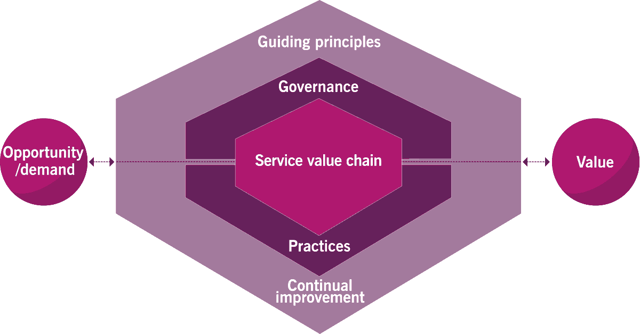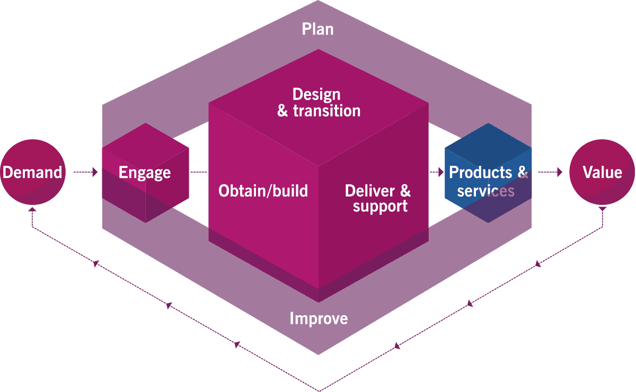Effective IT Service Management (ITSM) is crucial to assuring seamless service delivery, enhancing customer satisfaction, and propelling business success in today's swiftly evolving digital landscape.
With the introduction of ITIL 4 (Information Technology Infrastructure Library), the most recent release of the internationally recognised ITSM framework, organisations have the chance to adopt modern practices and achieve the maximum potential of their IT services. This article examines key ITSM related topics within the context of ITIL 4.
The fundamentals of ITIL 4
At its core, ITIL 4 is a framework that helps organisations align ITSM practices with business goals and objectives. It provides a set of best practices and guidelines for managing services throughout their lifecycle.
ITIL 4 focuses on value co-creation, flexibility, and continual improvement. By adopting ITIL 4, organisations can enhance their service delivery capabilities and create value for both their customers and their business as a whole.
Here are the fundamental components of ITIL 4:
-
Service Value System (SVS)
The SVS represents a holistic approach to manage services and it creates a common language and understanding across the organisation. The SVS consists of several interconnected components, including the Service Value Chain, guiding principles, governance, and continual improvement. This system enables organisations to collaborate effectively, focus on value creation, and drive service excellence.

Practical example: consider an e-commerce company that implements ITIL 4's Service Value System. The SVS assists them in incorporating many components of their ITSM practices. They create a Service Value Chain that connects their offerings with the needs of their customers.
Their SVC comprises steps such as “Engage”, where they proactively gather client feedback, “Obtain / Build”, where they optimise their infrastructure, and “Deliver & Support”, where they ensure seamless operations.
The guiding principles assist them in focusing on value, collaborating cross-functionally, and keeping processes simple yet efficient, ultimately improving customer satisfaction.
-
Service Value Chain (SVC)
The SVC is a critical element of ITIL 4, outlining the activities required to create and deliver value to clients. The SVC consists of six stages:
-
Plan;
-
Improve;
-
Engage;
-
Design & Transition;
-
Obtain / Build; and
-
Deliver & Support.
Each stage represents a set of interrelated processes and activities that contribute to the overall service value. By comprehending and optimising the SVC, organisations can streamline their operations, enhance customer satisfaction, and maximize the value delivered to their customers.
-
Practical example: consider an IT support company that is putting ITIL 4's Service Value Chain into practice. They develop a detailed incident management plan during the “Plan” stage. They employ feedback loops to continuously develop their incident management process during the “Improve” stage. They discover patterns in incidents and automate routine answers using the “Optimise and automate” principle, resulting in faster incident resolution and improved customer experience.
Guiding principles
ITIL 4 introduces seven guiding principles that provide organisations with a set of fundamental values and guidelines to inform their decision-making processes. These principles are:
-
Focus on value
Ensuring that all actions and decisions are driven by the value they create. -
Start where you are
Recognising and leveraging existing assets, capabilities, and processes. -
Progress interactively with feedback
Continuously improving through iterative feedback loops and learning. -
Collaborate and promote visibility
Encouraging cross-functional collaboration and transparency. -
Think and work holistically
Taking a holistic view of the organisation and its services. -
Keep it simple and practical
Striving for simplicity and practicality in all aspects of service management. -
Optimise and automate
Identifying opportunities for optimisation and automation to drive efficiency.
By applying these guiding principles, organisations can create a firm foundation for effective ITSM practices, fostering a culture of continual improvement and customer-centricity.
ITIL best practices
ITIL 4 defines a set of practices that organisations may use to manage their IT services effectively. Out of a total of 34 management practices, we find: incident management, problem management, change enablement, business relationship management, continual improvement, among others.
Each practice has a purpose, a set of activities, and desired outcomes. It is essential to note that ITIL 4 promotes a flexible approach to practices and encourages organisations to modify them to their specific needs. By employing these practices, organisations can enhance service quality, decrease disruption, and improve the overall customer experience.
Integrating ITIL 4 with Agile and DevOps
In today's fast-paced business environment, agility and collaboration are paramount. ITIL 4 recognises the significance of these principles and aligns with Agile and DevOps methodologies.
By combining ITIL 4 with Agile and DevOps practices, organisations can achieve faster delivery, greater flexibility, and increased customer satisfaction. The incorporation of these methodologies enables seamless collaboration between cross-functional teams, thereby eliminating silos and fostering a culture of collaboration and innovation.
Practical example: a software development company combines ITIL 4 with Agile and DevOps methodologies. They prioritise features and iterate quickly using Agile principles, while ITIL 4 assists them in maintaining service quality and stability. They incorporate DevOps practices to ensure that development and operations teams work together and collaborate with each other. As a result, they obtain faster software delivery cycles, better incident response times, and higher customer satisfaction.
Digital transformation and ITIL 4
In the era of digital transformation, ITIL 4 plays a crucial role in guiding organisations through the complexities of incorporating new technologies and processes. By leveraging ITIL 4 practices, organisations can ensure smooth transitions during digital initiatives like cloud adoption, Artificial Intelligence (AI) implementation, and automation.
ITIL 4 provides a structured approach for managing change, mitigating risks, and maximising the value of digital transformations. By adopting ITIL 4, organisations can accelerate their digital transformation initiatives and position themselves for success in the digital age.
Practical example: a traditional retailer starts a digital transformation path, using cloud services and AI to analyse customer data. They examine their existing skills and identify gaps for digital transformation by applying ITIL 4's “Start where you are” principle. The framework assists them in efficiently planning and executing the change, guaranteeing little disruption to the client services, and allowing them to fully reach the potential of new technology.
Conclusion
With all its comprehensiveness, flexibility and adaptability, ITIL 4 is more than just a recognised framework or methodology: it’s a true asset for businesses worldwide looking to guarantee efficiency, speed and excellence.
Whether you’re a leader looking to unlock your company’s full potential, or an IT professional searching for an opportunity to grow, adopting this approach and integrating it with Agile and DevOps will certainly lead to results. More importantly: it will help you stand out from the competition and overcome any obstacles getting in your way.

